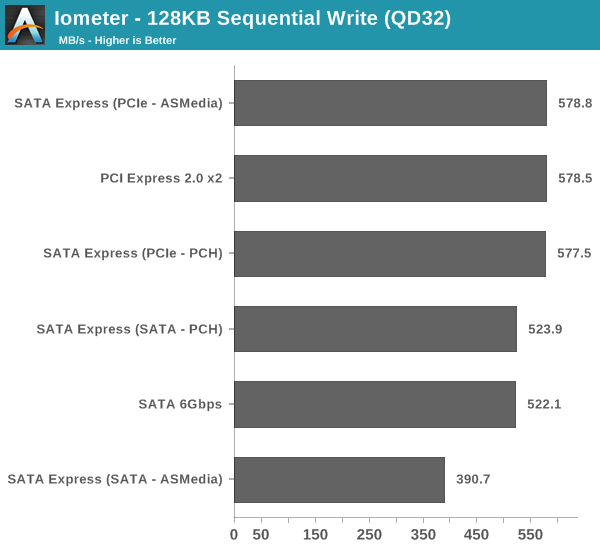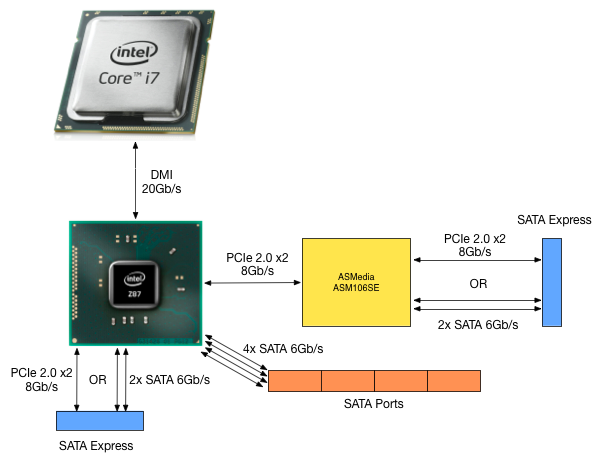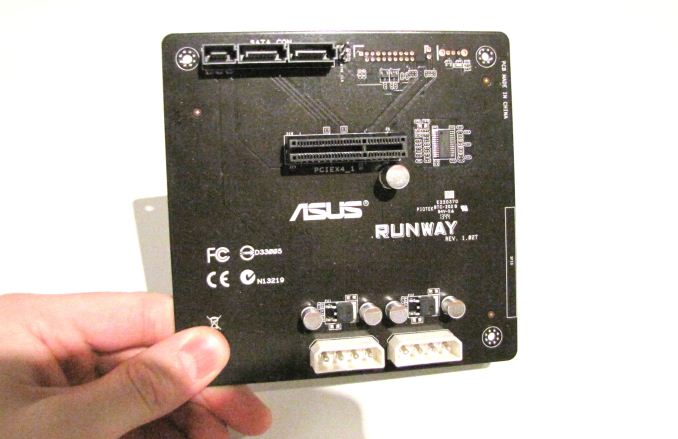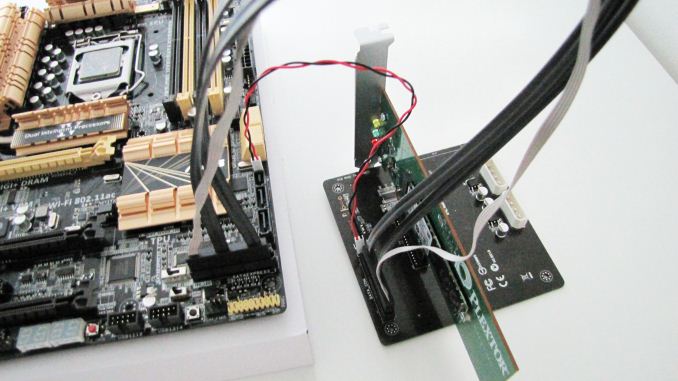Testing SATA Express And Why We Need Faster SSDs
by Kristian Vättö on March 13, 2014 7:00 AM EST- Posted in
- Storage
- SSDs
- Asus
- SATA
- SATA Express
Testing SATA Express
SATAe is not commercially available yet but ASUS sent us a pre-production unit of the SATA Express version of their Z87 Deluxe motherboard along with the necessary peripherals to test SATAe. This is actually the same motherboard as our 2014 SSD testbed but with added SATAe functionality.
| Test Setup | |
| CPU | Intel Core i7-4770K at 3.5GHz (Turbo & EIST enabled, C-states disabled) |
| Motherboard | ASUS Z87 Deluxe SATA Express (BIOS 1707) |
| Chipset | Intel Z87 |
| Chipset Drivers | 9.4.0.1026 |
| Storage Drivers | Intel RST 12.9.0.1001 |
| Memory | Corsair Vengeance DDR3-1866 2x8GB (9-10-9-27 2T) |
| Graphics | Intel HD Graphics 4600 |
| Graphics Drivers | 15.33.8.64.3345 |
| Power Supply | Corsair RM750 |
| OS | Windows 7 Ultimate 64-bit |
Before we get into the actual tests, we would like to thank the following companies for helping us with our 2014 SSD testbed.
- Thanks to Intel for the Core i7-4770K CPU
- Thanks to ASUS for the Z87 Deluxe motherboard
- Thanks to Corsair for the Vengeance 16GB DDR3-1866 DRAM kit, RM750 power supply, Hydro H60 CPU cooler and Carbide 330R case
The ASUS Z87 Deluxe SATA Express has two SATAe ports: one routed from the Platform Controller Hub (PCH) and the other provided by an ASMedia ASM106SE chip. The ASMedia is an unreleased chip, hence there is no information to be found about it and ASUS is very tight-lipped about the whole thing. I'm guessing we are dealing with the same SATA 6Gbps design as other ASM106x chips but with added PCIe pass-through functionality to make the chip suitable for SATA Express.
I did a quick block diagram that shows the storage side of the ASUS SATAe board we have. Basically there are four lanes in total dedicated to SATAe with support for up to two SATAe drives in addition to four SATA 6Gbps devices. Alternatively you can have up to eight SATA 6Gbps devices if neither of the SATAe ports is operating in PCIe mode.
Since there are no SATAe drives available at this point, ASUS sent us a SATAe demo daughterboard along with the motherboard. The daughterboard itself is very simple: it has the same SATAe connector as found in the motherboard, two molex power inputs, a clock cable header, and a PCIe slot.
This is what the setup looks like in action (though as you can see, I took the motherboard out of the case since inside case photos didn't turn out so well with the poor camera I have). The black and red cable is the external clock cable, which is only temporary and won't be needed with a final SATAe board.
The Tests
For testing I used Plextor's 256GB M6e PCIe SSD, which is a PCIe 2.0 x2 SSD with Marvell's new 88SS9183 PCIe controller. Plextor rates the M6e at up to 770MB/s read and 580MB/s write, so we should be capable of reaching the full potential of PCIe 2.0 x2. Additionally I tested the SATA 6Gbps ports with a 256GB OCZ Vertex 450. I used the same sequential 128KB Iometer tests that we use in our SSD reviews but I ramped up the queue depth to 32 to make sure we are looking at a maximum throughput situation.

There is no practical difference between a PCIe slot on the motherboard and PCIe that is routed through SATA Express. I'm a little surprised that there is absolutely no hit in performance (other than a negligible 1.5MB/s that's basically within the margin of error) because after all we are using cabling that should add latency. It seems that SATA-IO has been able to make the cabling efficient enough to transmit PCIe without additional overhead.
As for SATA 6Gbps, the performance is the same as well, which isn't surprising since only the connector is slightly different while electrically everything is the same. With the ASMedia chipset there is ~25-27% reduction in performance but that is inline with the previous ASMedia SATA 6Gbps chipsets I've seen. As I mentioned earlier, I doubt that the ASM106SE brings anything new to the SATA side of the controller and that's why I wasn't expecting more than 400MB/s. Generally you'll only get full SATA bandwidth from an Intel chipset or a higher-end SATA/RAID card.

The same goes for write performance. The only case where you are going to see a difference is if you connect to the ASMedia SATA 6Gbps port. I did run some additional benchmarks (like our performance consistency test) to see if a different workload would yield different results but all my tests showed that SATAe in PCIe mode is as fast as a real PCIe slot, so I'm not going to post a bunch additional graphs showing that the two are equivalent.













131 Comments
View All Comments
SirKnobsworth - Thursday, March 13, 2014 - link
Thunderbolt 2 is really PCIe x4 + DisplayPort in disguise, and you don't need DisplayPort to your SSD.MrSpadge - Thursday, March 13, 2014 - link
Couldn't you build a nice M.2 to SATAe adapter in a 2.5" form factor and thereby reuse your existing M.2 designs for SATAe?Kristian Vättö - Thursday, March 13, 2014 - link
Technically yes, but the problem is that M.2 is shaped differently. You could certainly fit a small M.2 drive with only few NAND packages in there but the longer, faster ones don't really fit inside 2.5".Kevin G - Thursday, March 13, 2014 - link
"At 24 frames per second, uncompressed 4K video (3840x2160, 12-bit RGB color) requires about 450MB/s of bandwidth, which is still (barely) within the limits of SATA 6Gbps."This is incorrect:
3840 * 2160 * 12 bit per channel * 3 channels / 8 bits per byte * 24 fps ~ 896 MByte/s
And that figure is with with good byte packing. For raw recording, the algorithm may pack the 12 bits into two bytes for speed purposes meaning you'd need about 1.2 Gbyte/s of bandwidth. Jumping to 4096 x 2160 resolution at 12 bit color and 30 fps, the bandwidth need grows to about 1.6 Gbyte/s.
The other thing worth noting is that uncompressed recording is going to take a lot of storage. A modern phone recording at the highest quality settings with 64 GB of storage would last less than 40 seconds before running out.
Kristian Vättö - Thursday, March 13, 2014 - link
Oh, you're absolutely right. I used the below calculator to calculate the bandwidth but accidentally left "interlaced" box ticked, which screwed up the results. Thanks for the heads up, fixing...Kristian Vättö - Thursday, March 13, 2014 - link
And the calculator... http://web.forret.com/tools/video_fps.asp?width=38...JarredWalton - Thursday, March 13, 2014 - link
Aren't there *four* channels, though? RGB and Alpha? Or is Alpha not used with 12-bit?Kevin G - Thursday, March 13, 2014 - link
No real way to record with an Alpha channel value to my knowledge. Cameras and scanners etc all presume a flattened image as if everything were solid. The only exception to this would be direct frame buffer capture from video memory which can independently process an Alpha channel.Input media would generally be 36 bit. During the editing phase an Alpha channel can be added as part of compositing pipeline bringing the total bit depth to 48 bit. Final rendering can be done to a 48 bit RGBA file. Display output on screen will be reduced to 36 bit due to compositing for the frame buffer.
Nightraptor - Thursday, March 13, 2014 - link
When I saw the daughterboard Asus provided my instant thought was actually using this (in pcie 3.0 form) to somehow provide the option to add an external GPU to a tablet. I may be the outlier, but my dream would be to have and 11.6" 16:10 1920 x 1200 tablet with the ability to connect a keyboard dock to function as a laptop, or another dock with a discrete graphics card to function as a desktop for occasional gaming (1080p at high setting would be all I'd ask for - so pcie 3.0 4x should be sufficient). If you could somehow get a SATAe cable on a tablet I think this would do it.vladman - Thursday, March 13, 2014 - link
If you want speed from storage, get a nice Areca PCIe RAID controller, attach 4 or more fast SSDs, do RAID 0, and you've got anywhere from 1.7 to 2GB/s of data transfer. Done deal.